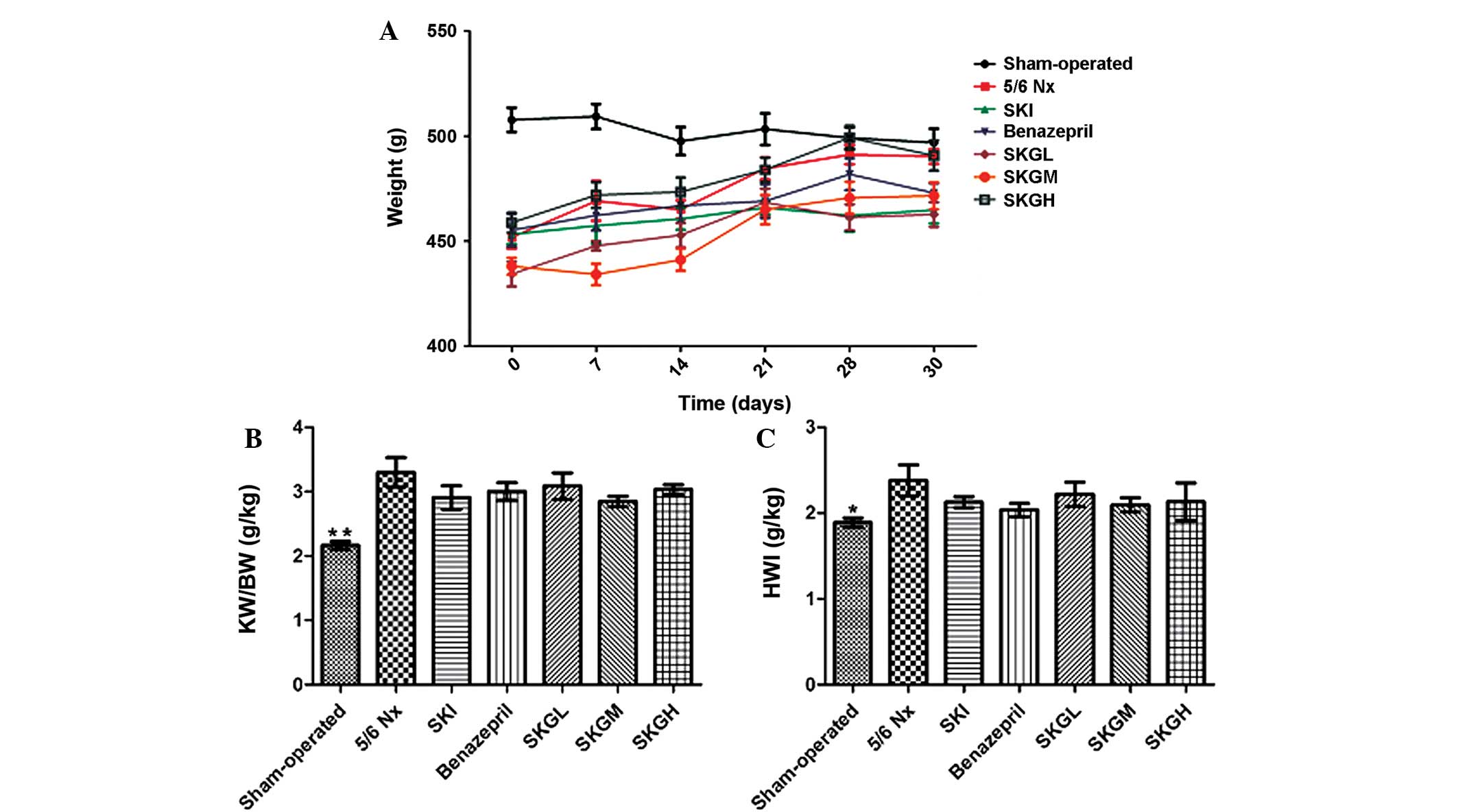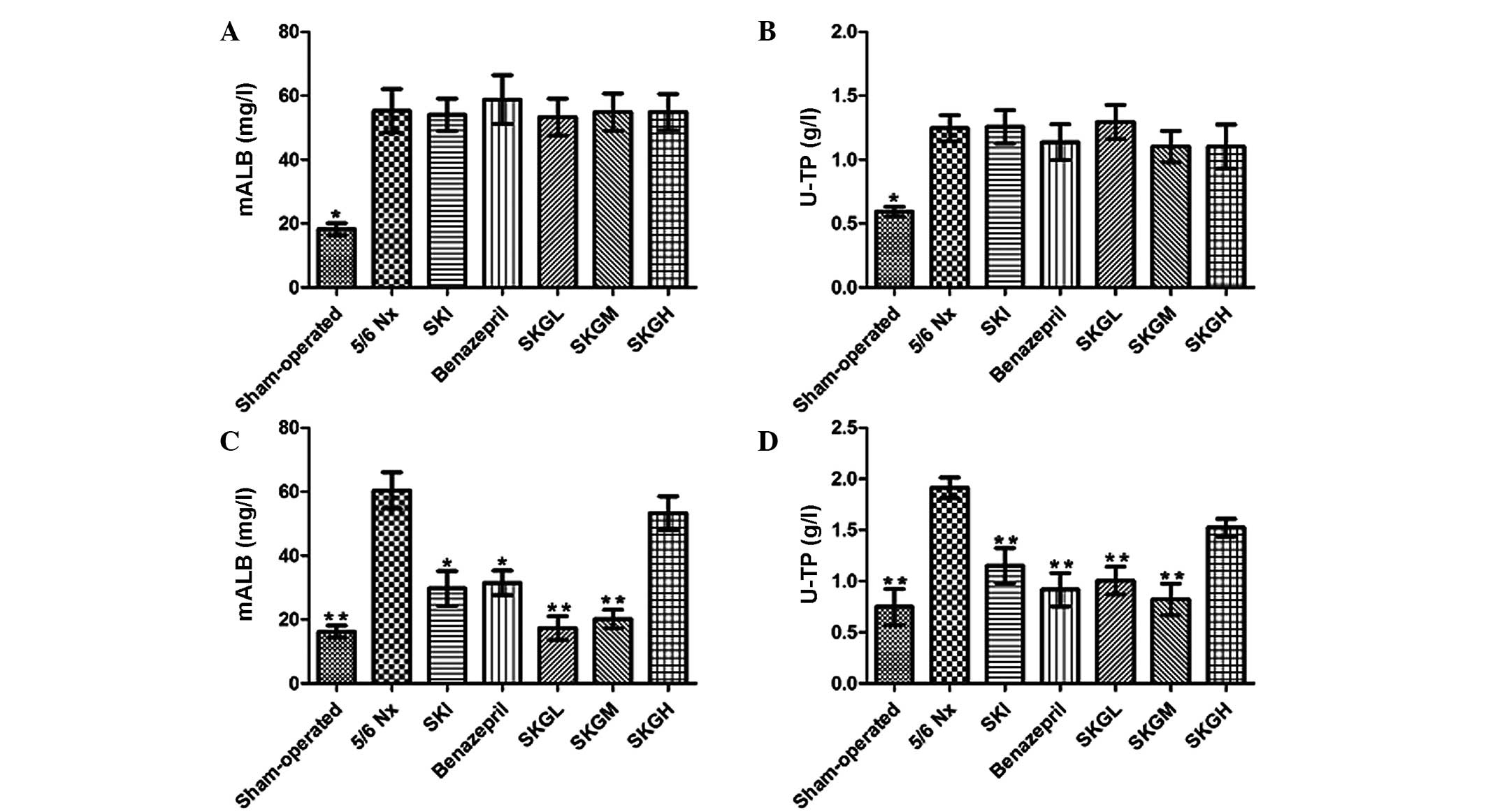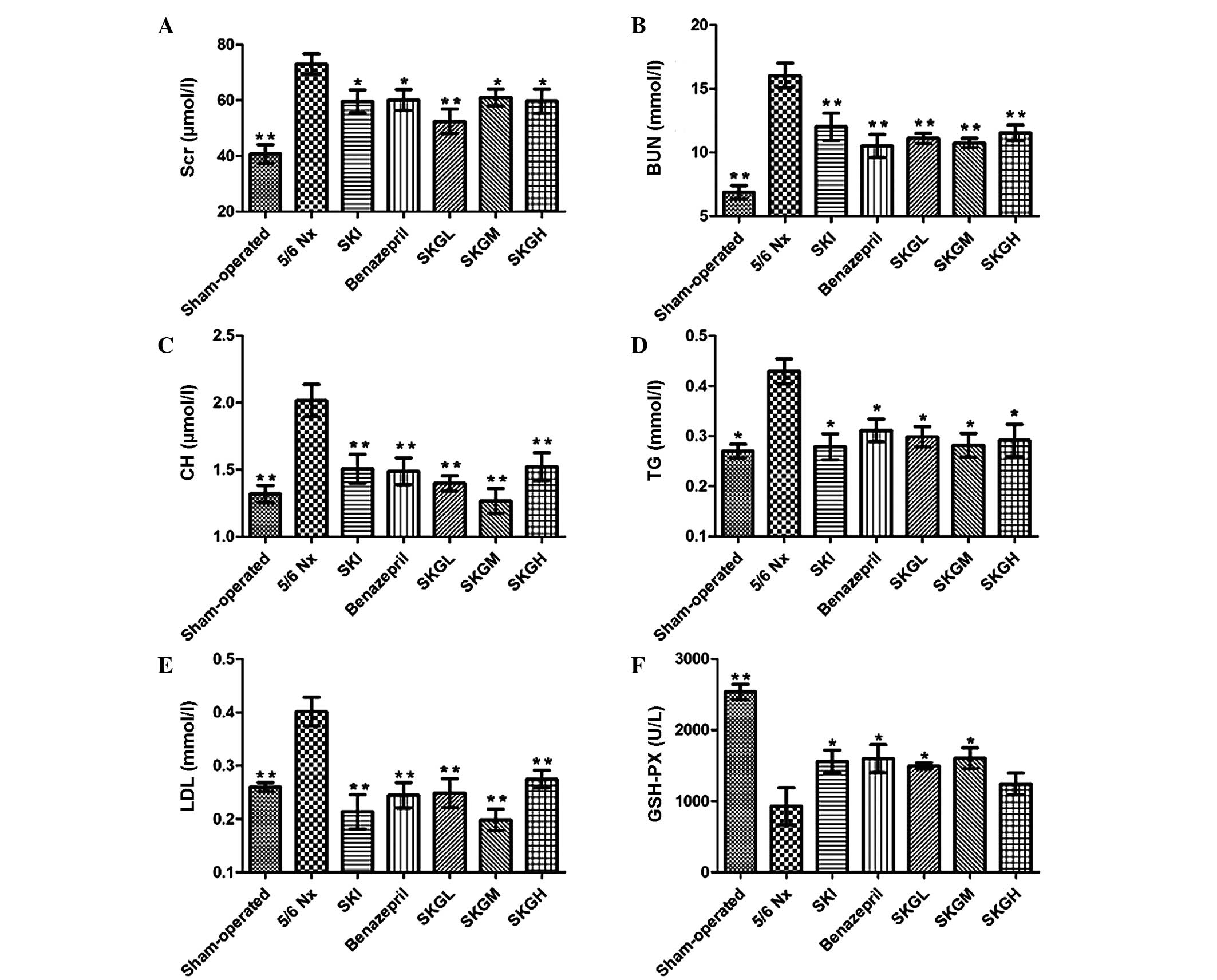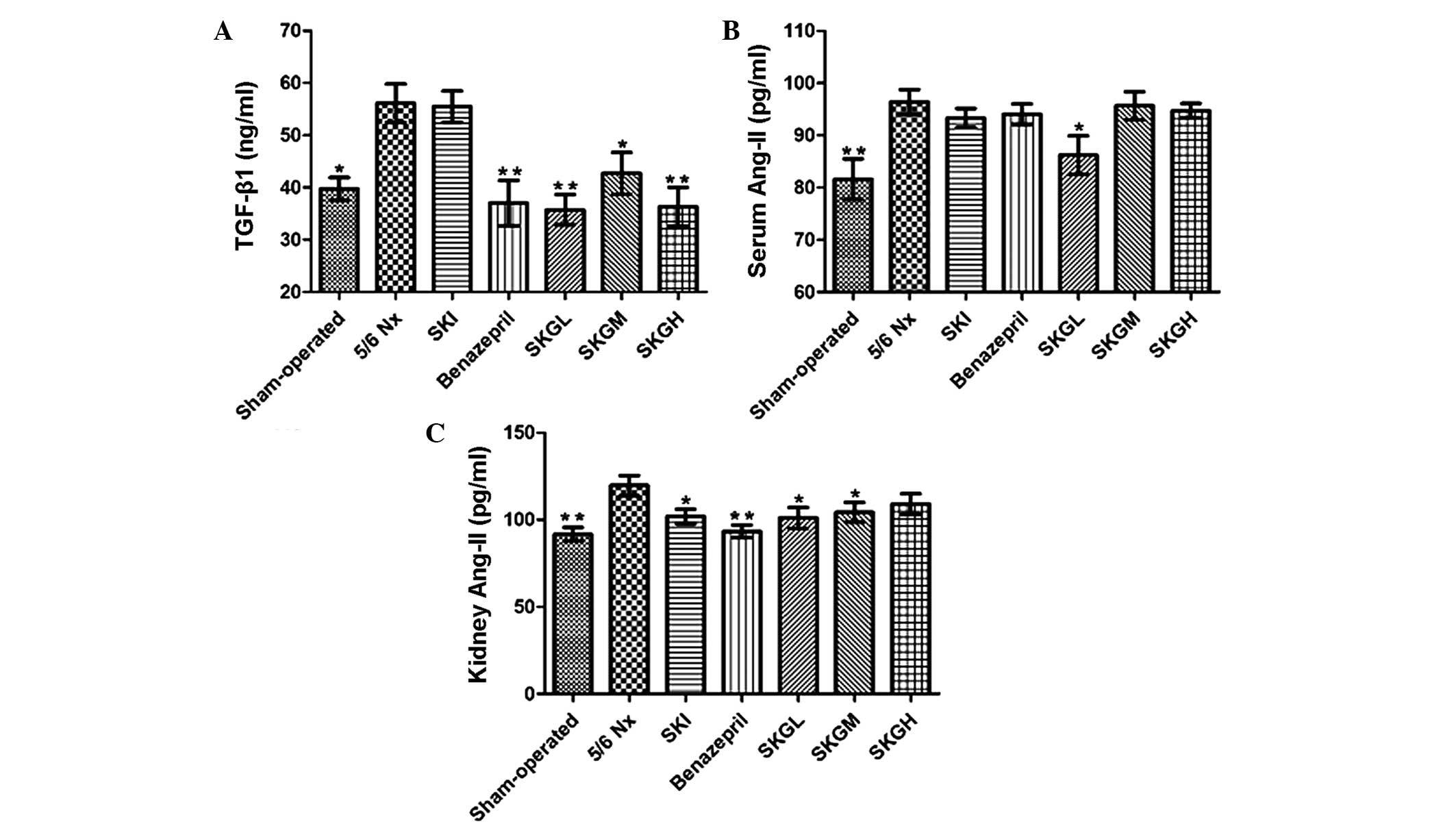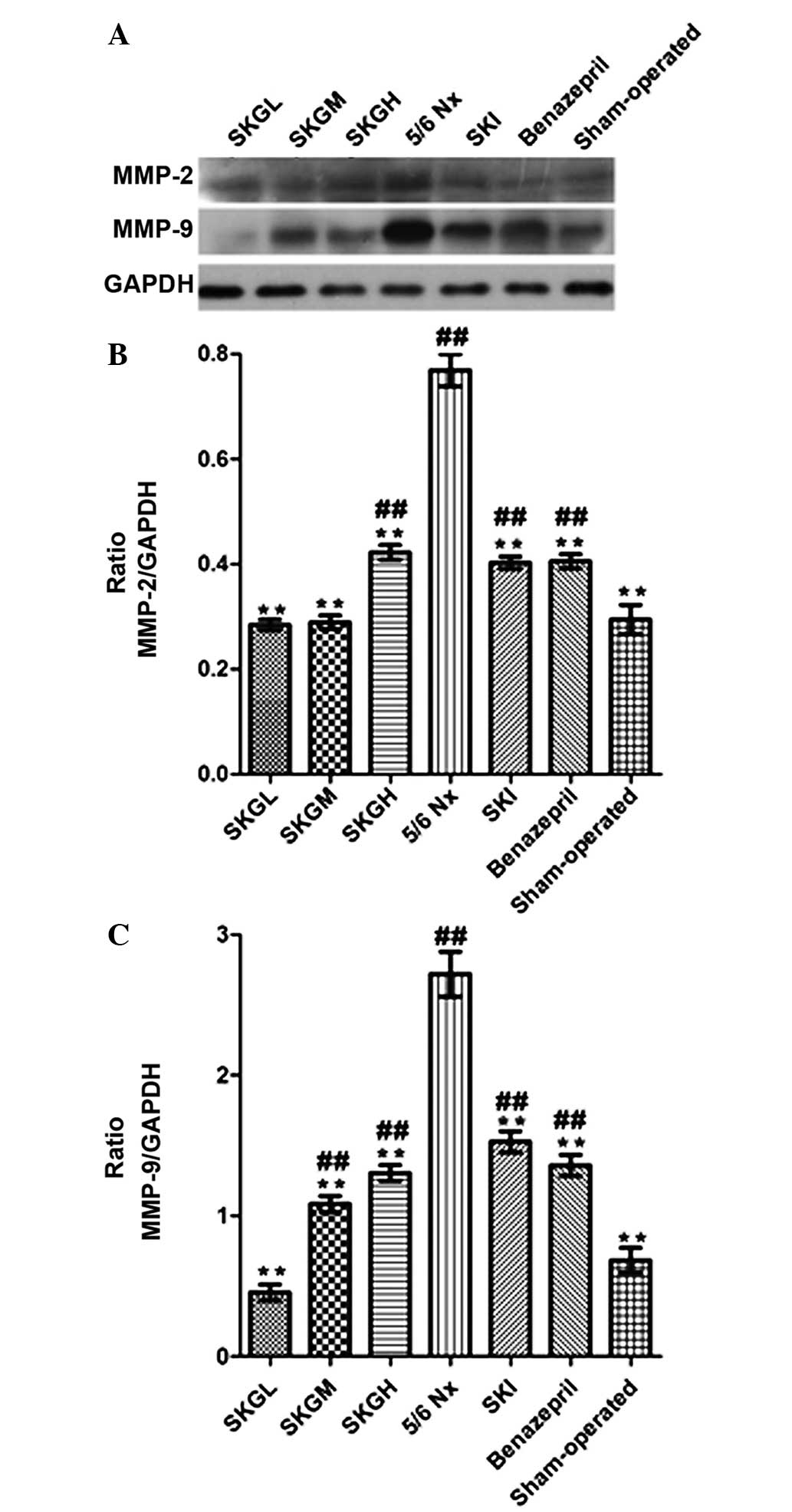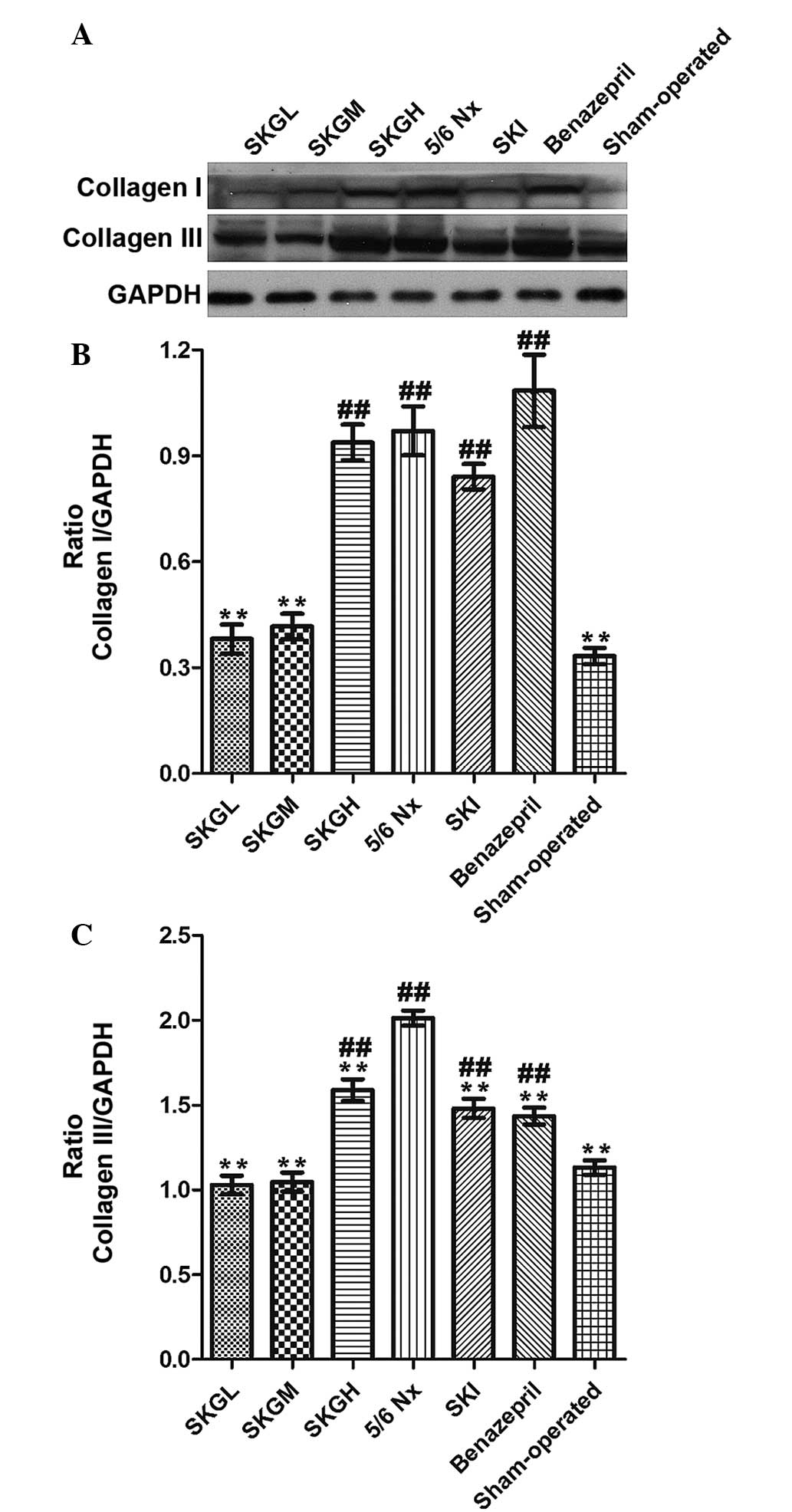|
1
|
Norman JT and Fine LG: Progressive renal
disease: fibroblasts, extracellular matrix, and integrins. Exp
Nephrol. 7:167–177. 1999. View Article : Google Scholar : PubMed/NCBI
|
|
2
|
Rossert J, Fouqueray B and Boffa JJ:
Anemia management and the delay of chronic renal failure
progression. J Am Soc Nephrol. 14:(7 Suppl 2). S173–S177. 2003.
View Article : Google Scholar : PubMed/NCBI
|
|
3
|
Sasaki S, Tohda C, Kim M and Yokozawa T:
Gamma-aminobutyric acid specifically inhibits progression of
tubular fibrosis and atrophy in nephrectomized rats. Biol Pharm
Bull. 30:687–691. 2007. View Article : Google Scholar : PubMed/NCBI
|
|
4
|
Tsujimura T, Nagamine J, Sugaru E, et al:
Combination therapy with SMP-534 and an angiotensin-converting
enzyme inhibitor provides additional renoprotection in 5/6
nephrectomized rats. Biol Pharm Bull. 32:1991–1996. 2009.
View Article : Google Scholar : PubMed/NCBI
|
|
5
|
El Nahas Meguid A and Bello AK: Chronic
kidney disease: the global challenge. Lancet. 365:331–340. 2005.
View Article : Google Scholar : PubMed/NCBI
|
|
6
|
Dellê H, Rocha JR, Cavaglieri RC, Vieira
JM Jr, Malheiros DM and Noronha IL: Antifibrotic effect of
tamoxifen in a model of progressive renal disease. J Am Soc
Nephrol. 23:37–48. 2012. View Article : Google Scholar : PubMed/NCBI
|
|
7
|
Jian DY, Chao YW, Ting CH, et al: Losartan
ameliorates renal injury, hypertension, and adipocytokine imbalance
in 5/6 nephrectomized rats. Eur J Pharmacol. 709:85–92. 2013.
View Article : Google Scholar : PubMed/NCBI
|
|
8
|
Cho KH, Kim HJ, Kamanna VS and Vaziri ND:
Niacin improves renal lipid metabolism and slows progression in
chronic kidney disease. Biochim Biophys Acta. 1800:6–15. 2010.
View Article : Google Scholar : PubMed/NCBI
|
|
9
|
Iyoda M, Shibata T, Wada Y, et al: Long-
and short-term treatment with imatinib attenuates the development
of chronic kidney disease in experimental anti-glomerular basement
membrane nephritis. Nephrol Dial Transplant. 28:576–584. 2013.
View Article : Google Scholar : PubMed/NCBI
|
|
10
|
Wang C, Duan H and He L: Inhibitory effect
of atractylenolide I on angiogenesis in chronic inflammation in
vivo and in vitro. Eur J Pharmacol. 612:143–152. 2009. View Article : Google Scholar : PubMed/NCBI
|
|
11
|
Du J, Chen H and Wang XB: Effect of
shenkang injection on hypertrophy and expressions of p21 and p27 in
glomerular mesangial cells of rats cultured in high glucose.
Zhongguo Zhong Xi Yi Jie He Za Zhi. 26:(Suppl). 68–71. 2006.[(In
Chinese)]. PubMed/NCBI
|
|
12
|
Xiao W, Wei LB, Ma Y, Long HB and Chen GB:
Renal protective effect of Shenkang pill on diabetic rats. Zhongguo
Zhong Yao Za Zhi. 31:1006–1009. 2006.[(In Chinese)]. PubMed/NCBI
|
|
13
|
Guo L, Liu Y and Mao W: Contrast study on
effect of shenkang injection and benazepril on human glomerular
mesangial extracellular matrix. Zhongguo Zhong Xi Yi Jie He Za Zhi.
20:50–52. 2000.[(In Chinese)]. PubMed/NCBI
|
|
14
|
Zhao Z, Li H and Zhang X: Effect of
shenkang injection on transforming growth factor-beta messenger
ribonucleic acid of LLC-PK1 renal tubular epithelial cells.
Zhongguo Zhong Xi Yi Jie He Za Zhi. 20:931–933. 2000.[(In
Chinese)]. PubMed/NCBI
|
|
15
|
Anderson S, Rennke HG and Brenner BM:
Therapeutic advantage of converting enzyme inhibitors in arresting
progressive renal disease associated with systemic hypertension in
the rat. J Clin Invest. 77:1993–2000. 1986. View Article : Google Scholar : PubMed/NCBI
|
|
16
|
Maschio G, Alberti D, Janin G, et al:
Effect of the angiotensin-converting-enzyme inhibitor benazepril on
the progression of chronic renal insufficiency. The
Angiotensin-Converting-Enzyme Inhibition in Progressive Renal
Insufficiency Study Group. N Engl J Med. 334:939–945. 1996.
View Article : Google Scholar : PubMed/NCBI
|
|
17
|
Ghosh SS, Massey HD, Krieg R, et al:
Curcumin ameliorates renal failure in 5/6 nephrectomized rats: role
of inflammation. Am J Physiol Renal Physiol. 296:F1146–F1157. 2009.
View Article : Google Scholar : PubMed/NCBI
|
|
18
|
Cao L, Xu CB, Zhang Y, Cao YX and
Edvinsson L: Secondhand smoke exposure induces
Raf/ERK/MAPK-mediated upregulation of cerebrovascular endothelin
ETA receptors. BMC Neurosci. 12:1092011. View Article : Google Scholar : PubMed/NCBI
|
|
19
|
Cao L, Zhang Y, Cao YX, Edvinsson L and Xu
CB: Cigarette smoke upregulates rat coronary artery endothelin
receptors in vivo. PLoS One. 7:e330082012. View Article : Google Scholar : PubMed/NCBI
|
|
20
|
Baraka A and El Ghotny S: Cardioprotective
effect of renalase in 5/6 nephrectomized rats. J Cardiovasc
Pharmacol Ther. 17:412–416. 2012. View Article : Google Scholar : PubMed/NCBI
|
|
21
|
Bai F, Makino T, Ono T and Mizukami H:
Anti-hypertensive effects of shichimotsukokato in 5/6
nephrectomized Wistar rats mediated by the DDAH-ADMA-NO pathway. J
Nat Med. 66:583–590. 2012. View Article : Google Scholar : PubMed/NCBI
|
|
22
|
Ma RX, Zhao N and Zhang W: The effects and
mechanism of Tripterygium wilfordii Hook F combination with
irbesartan on urinary podocyte excretion in diabetic nephropathy
patients. Zhonghua Nei Ke Za Zhi. 52:469–473. 2013.[(In Chinese)].
PubMed/NCBI
|
|
23
|
Cozzolino M, Staniforth ME, Liapis H, et
al: Sevelamer hydrochloride attenuates kidney and cardiovascular
calcifications in long-term experimental uremia. Kidney Int.
64:1653–1661. 2003. View Article : Google Scholar : PubMed/NCBI
|
|
24
|
Tapia E, Zatarain-Barrón ZL,
Hernández-Pando R, et al: Curcumin reverses glomerular hemodynamic
alterations and oxidant stress in 5/6 nephrectomized rats.
Phytomedicine. 20:359–366. 2013. View Article : Google Scholar : PubMed/NCBI
|
|
25
|
Zhao G, Zhao H, Tu L, et al: Effects and
mechanism of irbesartan on tubulointerstitial fibrosis in 5/6
nephrectomized rats. J Huazhong Univ Sci Technolog Med Sci.
30:48–54. 2010. View Article : Google Scholar : PubMed/NCBI
|
|
26
|
Monostori P, Kocsis GF, Ökrös Z, et al:
Different administration schedules of darbepoetin alfa affect
oxidized and reduced glutathione levels to a similar extent in 5/6
nephrectomized rats. Clin Exp Nephrol. 17:569–574. 2013. View Article : Google Scholar : PubMed/NCBI
|
|
27
|
Konda T, Enomoto A, Takahara A and
Yamamoto H: Effects of L/N-type calcium channel antagonist,
cilnidipine on progressive renal injuries in Dahl salt-sensitive
rats. Biol Pharm Bull. 29:933–937. 2006. View Article : Google Scholar : PubMed/NCBI
|
|
28
|
Noda M, Matsuo T, Fukuda R, et al: Effect
of candesartan cilexetil (TCV-116) in rats with chronic renal
failure. Kidney Int. 56:898–909. 1999. View Article : Google Scholar : PubMed/NCBI
|
|
29
|
Romero F, Rodríguez-Iturbe B, Parra G,
González L, Herrera-Acosta J and Tapia E: Mycophenolate mofetil
prevents the progressive renal failure induced by 5/6 renal
ablation in rats. Kidney Int. 55:945–955. 1999. View Article : Google Scholar : PubMed/NCBI
|
|
30
|
Mori Y and Hirano T: Ezetimibe alone or in
combination with pitavastatin prevents kidney dysfunction in 5/6
nephrectomized rats fed high-cholesterol. Metabolism. 61:379–388.
2012. View Article : Google Scholar : PubMed/NCBI
|
|
31
|
Zager RA, Johnson AC and Becker K: Acute
unilateral ischemic renal injury induces progressive renal
inflammation, lipid accumulation, histone modification, and
‘end-stage’ kidney disease. Am J Physiol Renal Physiol.
301:F1334–F1345. 2011. View Article : Google Scholar : PubMed/NCBI
|
|
32
|
Houlihan CA, Akdeniz A, Tsalamandris C,
Cooper ME, Jerums G and Gilbert RE: Urinary transforming growth
factor-beta excretion in patients with hypertension, type 2
diabetes, and elevated albumin excretion rate: effects of
angiotensin receptor blockade and sodium restriction. Diabetes
Care. 25:1072–1077. 2002. View Article : Google Scholar : PubMed/NCBI
|
|
33
|
Gaedeke J, Peters H, Noble NA and Border
WA: Angiotensin II, TGF-beta and renal fibrosis. Contrib Nephrol.
135:153–160. 2001. View Article : Google Scholar : PubMed/NCBI
|
|
34
|
Noronha IL, Fujihara CK and Zatz R: The
inflammatory component in progressive renal disease - are
interventions possible? Nephrol Dial Transplant. 17:363–368. 2002.
View Article : Google Scholar : PubMed/NCBI
|
|
35
|
He L, Shen P, Fu Q, et al:
Nephro-protective effect of Kangqianling decoction on chronic renal
failure rats. J Ethnopharmacol. 122:367–373. 2009. View Article : Google Scholar : PubMed/NCBI
|
|
36
|
Kim SK, Jung KH and Lee BC: Protective
effect of Tanshinone IIA on the early stage of experimental
diabetic nephropathy. Biol Pharm Bull. 32:220–224. 2009. View Article : Google Scholar : PubMed/NCBI
|
|
37
|
Demosthenous P, Voskarides K, Stylianou K,
et al: Hellenic Nephrogenetics Research Consortium: X-linked Alport
syndrome in Hellenic families: phenotypic heterogeneity and
mutations near interruptions of the collagen domain in COL4A5. Clin
Genet. 81:240–248. 2012. View Article : Google Scholar : PubMed/NCBI
|
|
38
|
Soylemezoglu O, Wild G, Dalley AJ, et al:
Urinary and serum type III collagen: markers of renal fibrosis.
Nephrol Dial Transplant. 12:1883–1889. 1997. View Article : Google Scholar : PubMed/NCBI
|
|
39
|
Ding J, Yang J, Liu J and Yu L:
Immunofluorescence study of type IV collagen alpha chains in
epidermal basement membrane: application in diagnosis of X-linked
Alport syndrome. Chin Med J (Engl). 110:584–586. 1997.PubMed/NCBI
|
|
40
|
Duong Van Huyen JP, Viltard M, Nehiri T,
et al: Expression of matrix metalloproteinases MMP-2 and MMP-9 is
altered during nephrogenesis in fetuses from diabetic rats. Lab
Invest. 87:680–689. 2007. View Article : Google Scholar : PubMed/NCBI
|
|
41
|
Marson BP, Lacchini R, Belo V, et al:
Matrix metalloproteinase (MMP)-2 genetic variants modify the
circulating MMP-2 levels in end-stage kidney disease. Am J Nephrol.
35:209–215. 2012. View Article : Google Scholar : PubMed/NCBI
|
|
42
|
Lee ES, Shen Q, Pitts RL, et al: Serum
metalloproteinases MMP-2, MMP-9, and metalloproteinase tissue
inhibitors in patients are associated with arteriovenous fistula
maturation. J Vasc Surg. 54:454–460. 2011. View Article : Google Scholar : PubMed/NCBI
|
|
43
|
Pawlak K, Mysliwiec M and Pawlak D:
Peripheral blood level alterations of MMP-2 and MMP-9 in patients
with chronic kidney disease on conservative treatment and on
hemodialysis. Clin Biochem. 44:838–843. 2011. View Article : Google Scholar : PubMed/NCBI
|















